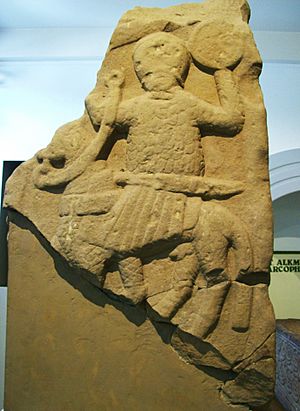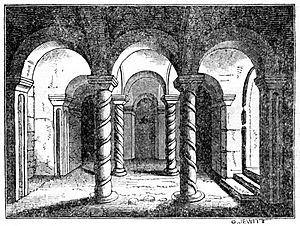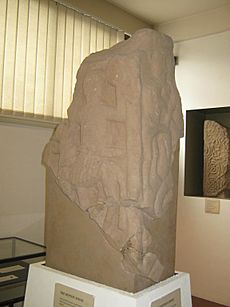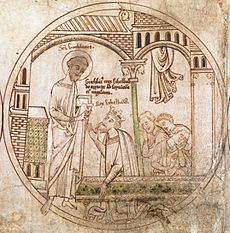Æthelbald of Mercia facts for kids
Quick facts for kids Æthelbald |
|
|---|---|

The Repton Stone which may depict Æthelbald
|
|
| King of Mercia | |
| Reign | 716–757 |
| Predecessor | Ceolred |
| Successor | Beornred |
| Born | Unknown |
| Died | 757 Seckington |
| Burial | Repton |
| House | Iclingas |
| Father | Alweo |
Æthelbald (also called Ethelbald or Aethelbald) was a powerful king of Mercia, a kingdom in what is now the English Midlands. He ruled for a long time, from 716 until he was killed in 757. Æthelbald was the son of Alweo and the grandson of King Eowa. He became king after his cousin, King Ceolred, passed away. Ceolred had actually forced Æthelbald to leave the kingdom before.
During Æthelbald's long rule, Mercia became the strongest kingdom among the Anglo-Saxons. It regained the important position it had under earlier Mercian kings like Penda and Wulfhere (around 628 to 675).
When Æthelbald first became king, other kingdoms like Wessex and Kent were very strong. But within 15 years, a writer named Bede said that Æthelbald ruled all of England south of the Humber river. Even though the Anglo-Saxon Chronicle doesn't call him a "bretwalda" (a ruler of Britain), this might be because the Chronicle was written by people from Wessex.
Around 745, St. Boniface wrote a letter to Æthelbald. He gently criticized the king for some of his actions, encouraging him to be a better Christian ruler. As a result, a church meeting called the Council of Clovesho was held in 747. Also, in 749, Æthelbald issued a special document at Gumley that gave the church more freedom from certain duties. These actions might have been a response to Boniface's letter.
Æthelbald was killed in 757 by his own bodyguards. After him, Beornred ruled briefly. But within a year, Offa, a relative of Æthelbald, took the throne. Offa's rule marked an even more successful time for Mercia.
Contents
Early Life and Becoming King
Æthelbald was part of the Mercian royal family, even though his father, Alweo, was never king. Alweo's father was Eowa, who might have shared the throne with his brother, Penda, for a while. The Anglo-Saxon Chronicle doesn't mention Eowa, but other old writings do.
When Æthelbald was young, Penda's family ruled Mercia. Ceolred, a grandson of Penda and Æthelbald's second cousin, was king from 709 to 716. An old book called Felix's Life of Saint Guthlac tells us that Ceolred forced Æthelbald to leave the kingdom.
Guthlac was a Mercian nobleman who became a monk and then a hermit. While Æthelbald was in exile, he and his men found safety in the Fens (a marshy area) and visited Guthlac. Guthlac supported Æthelbald, possibly because Ceolred was not kind to monasteries. After Guthlac died, Æthelbald had a dream where Guthlac predicted he would become a great king. Later, when Æthelbald was king, he honored Guthlac with a special shrine.
When King Ceolred died suddenly at a feast, Æthelbald returned to Mercia and became the new ruler. It's possible that a king named Ceolwald ruled for a very short time between Ceolred and Æthelbald. Æthelbald's rule marked the end of Penda's direct family line on the throne. After Æthelbald, and a short break, Offa became king, who was also a descendant of Eowa.
We don't know much about Æthelbald's close family, except for his father, Alweo. However, some old documents show that a powerful nobleman named Heardberht was recorded as his brother.
Mercia Becomes Powerful
Æthelbald's time as king brought Mercia back to power. This strong period lasted until the end of the 700s. Except for the very short rule of Beornrad, Mercia was led for 80 years by two of the most powerful Anglo-Saxon kings: Æthelbald and Offa. Having such long-ruling kings was unusual back then. For example, during the same period, Northumbria had 11 different kings, and many of them died violently.
By 731, Æthelbald was the main ruler over all the English kingdoms south of the Humber river. This meant other kings were dependent on him. A king under an overlord like Æthelbald was still called a king, but his independence was limited.
Old documents called Charters are important for understanding these relationships. These documents gave land to people or to the church. They were signed by kings who had the power to grant the land. If a charter gave land in a subject kingdom, it might list both the local king and the overlord on the witness list. For example, the Ismere Diploma shows this. Sometimes, a king might be called a "subregulus," meaning an "underking."
We have enough information to see how Æthelbald's power grew over Wessex and Kent. When Æthelbald became king, both Kent and Wessex had strong rulers: Wihtred and Ine. Wihtred of Kent died in 725. Ine of Wessex, a very strong ruler, gave up his throne in 726 to go on a religious journey to Rome.
According to the Anglo-Saxon Chronicle, Ine's successor, Aethelheard, fought with a nobleman named Oswald. Aethelheard won this fight for the throne. Later, it seems he ruled under Mercian authority. This suggests Æthelbald might have helped Aethelheard and his brother, Cuthred, who became king after Aethelheard in 739.
For Kent, old Kentish documents show that Æthelbald supported Kentish churches. However, there's no direct proof that Kentish kings needed Æthelbald's permission for land grants. It's possible such documents are just lost.
We know less about Essex, but around this time, London became part of Mercia instead of Essex. From Æthelbald's time onward, Mercia clearly controlled London.
Even with some missing evidence, the writer Bede, who lived at the same time, said in 731 that "all these provinces, together with the others south of the river Humber and their kings, are subject to Æthelbald, King of the Mercians." This shows how powerful he was.
Æthelbald sometimes had to fight to keep his power. In 733, he attacked Wessex and captured the royal estate of Somerton. The Anglo-Saxon Chronicle also says that when Cuthred became king of Wessex in 740, he "boldly made war against Aethelbald." Three years later, Cuthred and Æthelbald fought together against the Welsh. This might have been a duty Mercia placed on Cuthred. In 752, Æthelbald and Cuthred fought each other again. At Burford, Cuthred defeated Æthelbald. However, Æthelbald seems to have regained control over Wessex by the time he died. A later West Saxon king, Cynewulf, signed one of Æthelbald's documents in 757, at the start of his own rule.
In 740, there was a war between the Picts and the Northumbrians. Æthelbald, who might have been allied with Óengus, the Pictish king, used this chance to attack Northumbria while its king, Eadberht, was away. He may have even burned York.
Titles and "Britain-Ruler"

Bede, in his book Ecclesiastical History of the English People, listed seven kings who ruled the southern English kingdoms. Later, the Anglo-Saxon Chronicle called these kings "bretwaldas" or "brytenwaldas," which means "Britain-ruler" or "Wide-ruler." The Chronicle only added one more king to this list: Egbert of Wessex, who ruled much later.
This list of eight "bretwaldas" leaves out several strong Mercian kings, including Æthelbald. The writer of the Chronicle was likely from Wessex, so they might not have mentioned Æthelbald or Offa out of pride for their own region. Historians have studied what "bretwalda" truly meant. One idea is that since Bede wrote during Æthelbald's reign, the seven kings he listed were like earlier versions of Æthelbald, showing how they dominated southern England.
More proof of Æthelbald's power comes from an important document from 736, called the Ismere Diploma. It describes Æthelbald as "king not only of the Mercians but also of all the provinces which are called by the general name South English." In the list of witnesses, he is also called "Rex Britanniae," which means "King of Britain." One historian said this title is a Latin way of saying "Bretwalda." However, these titles might have been mainly used in the area where the documents were written.
Relations with the Church
Around 745–746, Boniface, a leading Anglo-Saxon missionary in Germany, along with seven other bishops, sent Æthelbald a strong letter. They criticized him for various actions, asking him to respect church property and privileges more.
Boniface first sent the letter to Ecgberht, the archbishop of York, asking him to check it and add anything needed. He also asked a priest named Herefrith, whom Æthelbald had listened to before, to read and explain the letter to the king in person. Even though Boniface's letter praised Æthelbald's faith, its criticisms have shaped how people view Æthelbald today.
Æthelbald might have influenced the choice of archbishops of Canterbury, including Tatwine, Nothelm, and Cuthbert. Despite Boniface's criticisms, Æthelbald did show positive interest in church matters. Boniface later sent a letter to Cuthbert, Archbishop of Canterbury, with information about church meetings in Frankish lands. Boniface seemed to suggest that Cuthbert should hold a similar meeting.

A church council was indeed held later at Clovesho (we don't know its exact location today). Æthelbald attended and perhaps led the meeting. The council discussed the relationship between the church and the everyday world. It also spoke out against bad behavior by clergy members. The council limited how much monks could interact with laypeople and said that monks should not do worldly things, forbidding secular business and "ludicrous songs."
Two years later, in 749, at a meeting in Gumley, Æthelbald issued a document. This document freed church lands from all duties except for building forts and bridges. These duties were called the trinoda necessitas and applied to everyone. This document was only signed by Mercian bishops, so it might have only applied within Mercia. However, it could also have been part of a larger plan for church reform, inspired by Boniface and started at Clovesho.
Death

In 757, Æthelbald was killed at Seckington, Warwickshire, near the royal town of Tamworth. A later continuation of Bede's Ecclesiastical History says he was "treacherously murdered at night by his own bodyguards." The reason for his death is not known.
He was briefly followed by Beornrad. Æthelbald was buried at St Wystan's Church, Repton, in a crypt that can still be seen today. Someone living at the time reportedly had a vision of him in hell, which suggests he wasn't always well-liked. The monastery church at Repton at that time was probably built by Æthelbald to be a royal burial place. Other important people, like Wigstan, were also buried there.
A piece of a cross from Repton has a carving of a man on horseback. Some people think this might be a memorial to Æthelbald. The figure wears armor and holds a sword and shield, with a crown on his head. If it is Æthelbald, it would be the earliest large picture of an English king.
See also
 In Spanish: Ethelbaldo de Mercia para niños
In Spanish: Ethelbaldo de Mercia para niños




